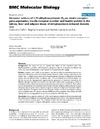Identificador persistente para citar o vincular este elemento:
https://accedacris.ulpgc.es/jspui/handle/10553/43010
| Título: | Genomic actions of 1,25-dihydroxyvitamin D3 on insulin receptor gene expression, insulin receptor number and insulin activity in the kidney, liver and adipose tissue of streptozotocin-induced diabetic rats | Autores/as: | Calle, Consuelo Maestro, Begoña García-Arencibia, Moisés |
Clasificación UNESCO: | 320504 Hematología 32 Ciencias médicas 230214 Glúcidos 2302 Bioquímica |
Palabras clave: | Insulin receptor Epididymal adipose tissue Insulin receptor gene Direct transcriptional activation Insulin receptor mRNA |
Fecha de publicación: | 2008 | Editor/a: | 1471-2199 | Publicación seriada: | BMC Molecular Biology | Resumen: | Background this study set out to examine the effects of the treatment with 1,25-dihydroxyvitamin D3 (1,25D3) [150 IU/Kg (3.75 μg/Kg) one a day, for 15 days] to non-diabetic rats and in rats rendered diabetic by a single injection of streptozotocin [65 mg/kg]. Results treatment with 1,25D3 to non-diabetic rats did not affect the biochemical parameters measured in the plasma and urine of these animals. Likewise, insulin receptor expression in the kidney, liver, or adipose tissue and insulin-stimulated glucose transport in adipocytes from these animals were not affected either. Treatment with 1,25D3 to streptozotocin-induced diabetic rats did not correct the hyperglycemia, hypoinsulinemia, glycosuria or ketonemia induced by the diabetes, although it partially reversed the over-expression of the insulin receptor gene in the liver and adipose tissue, without altering the normal expression of this gene in the kidney. These effects were accompanied by a normalization of the number of insulin receptors without altering receptor affinity but improving the insulin response to glucose transport in adipocytes from these diabetic animals. Moreover, a computer search in the rat insulin receptor promoter revealed the existence of two candidate vitamin D response element (VDRE) sequences located at -256/-219 bp and -653/-620 bp, the first overlapped by three and the second by four AP-2-like sites. Conclusion these genomic actions of 1,25D3 could represent beneficial effects associated with the amelioration of diabetes via mechanisms that possibly involve direct transcriptional activation of the rat insulin receptor gene. The candidate VDREs identified may respond to 1,25D3 via activation of the vitamin D receptor, although this remains to be investigated. | URI: | https://accedacris.ulpgc.es/handle/10553/43010 | ISSN: | 1471-2199 | DOI: | 10.1186/1471-2199-9-65 | Fuente: | Bmc Molecular Biology[ISSN 1471-2199],v. 9 |
| Colección: | Artículos |
Citas SCOPUSTM
88
actualizado el 08-jun-2025
Citas de WEB OF SCIENCETM
Citations
79
actualizado el 08-jun-2025
Visitas
159
actualizado el 27-sep-2025
Descargas
115
actualizado el 27-sep-2025
Google ScholarTM
Verifica
Altmetric
Comparte
Exporta metadatos
Los elementos en ULPGC accedaCRIS están protegidos por derechos de autor con todos los derechos reservados, a menos que se indique lo contrario.
